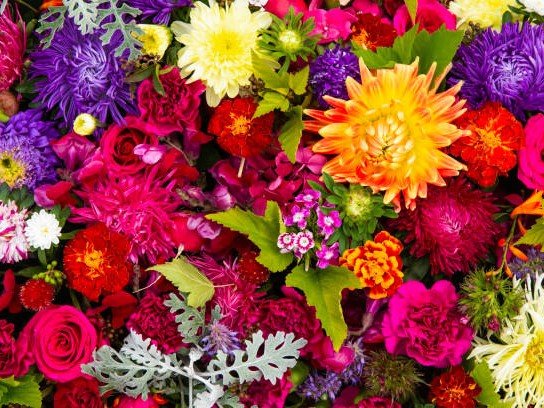
Autumn plants
Do you lack ideas and inspiration to get your garden or terrace ready for the autumn?
Then keep reading here, learn about autumn planting and the best plants and flowers you can add to your garden or balcony to create a colorful and atmospheric autumn landscape, get some tips for taking care of your planters, and a few ideas for what you can plant in the fall.
Autumn is a beautiful time of the year when nature transforms with warm, deep colors. If you want to bring this magical atmosphere into your garden or balcony, it's time to consider autumn planting. With the right plants and flowers, you can create a fantastic autumn landscape that will delight you and your guests. In this blog post, we will introduce you to some of the best plants and flowers that are perfect for the fall.

- Chrysanthemum: Chrysanthemum, also known as "mums," is a classic autumn flower with its vibrant colors and flowers in various shapes and sizes. From deep red to yellow and orange to blooming white shades, chrysanthemums offer a fantastic color palette for your autumn garden.

-
Ornamental Grasses: Ornamental grasses like miscanthus and pennisetum add structure and movement to your garden in the fall. Their tall stems and golden or red hues create a dramatic appearance, especially when the autumn winds set them in motion.

-
Sedum: Sedum is known for its thick and succulent leaves, as well as its flat flower clusters in shades of pink, red, and copper. These plants are hardy and require minimal care, making them ideal for the autumn.

-
Winter Heath: Winter heath blooms from late summer into autumn with its small flowers in shades of white, pink, and purple. In addition to their colorful flowers, winter heath also has a pleasant fragrance that can add an extra dimension to your garden.

-
Ornamental Pumpkins: Looking for a festive autumn decoration? Ornamental pumpkins are an obvious choice! In addition to being fun to carve and create spooky faces, they also add a festive atmosphere to your garden or balcony.

-
Japanese Maples: Japanese maples, such as the Japanese maple, are renowned for their stunning foliage in the fall. With beautiful shades of red, orange, and yellow, they create a wonderful color scheme that is perfect for the autumn.

-
Asters: Asters are beautiful flowers that bloom in late summer and continue into the fall. Their colorful flower heads, resembling small stars, come in various hues such as purple, blue, pink, and white.

Autumn doesn't have to be a time of dull colors in your garden or on your balcony. With these ideas for the best plants and flowers, you can create an enchanting autumn landscape filled with colorful shades and beauty. Whether you prefer flowers, grasses, or decorative pumpkins, there are plenty of options to choose from. So grab your garden shears and get started on planting to create a beautiful autumn landscape in your planters and raised beds that will impress everyone.
Tips for autumn care of your garden, planters, and raised beds:
Here are some helpful tips on how to take care of your garden, planters, and raised beds during the fall:
-
Remove dead leaves and weeds: Keep your garden, planters, and raised beds clean by regularly removing dead leaves and weeds. This prevents diseases and pests from taking hold and provides space for new plants and flowers to thrive.
-
Prune and trim: Fall is a good time to prune dead branches and shape bushes, trees, and plants in your planters and raised beds. Remove dead or diseased plant material to prevent the spread of diseases and create space for new growth.
-
Add compost: Enrich the soil around plants and flowers in your planters and raised beds with compost or organic material. This improves soil structure, retains moisture, and provides essential nutrients to the plants.
-
Water carefully: Even though the weather is cooler, it's still essential to water plants and flowers in your planters and raised beds regularly. Check the soil's moisture level and water when necessary. However, avoid overwatering, as excess moisture can lead to root damage.
-
Protect from frost: As temperatures begin to drop, protect delicate plants in your planters and raised beds from frost. Use straw, frost cloth, or other protective materials to insulate and keep the plants warm.
-
Add autumn plants: Replace summer flowers in your planters and raised beds with autumn plants that thrive in the cooler season. The plants and flowers mentioned in the previous blog post are good choices. They add color and beauty to both the garden and the planters/raised beds, even as autumn arrives.
-
Beware of pests: Certain pests are more active in the fall. Keep an eye on them and combat them if necessary. You can use natural insecticides or physical barriers to protect your plants in both planters and raised beds from damage.
-
Focus on autumn fertilization: Use appropriate autumn fertilizer to supply your plants in planters and raised beds with the necessary nutrients before winter. Follow the instructions on the fertilizer product to ensure proper dosing and application.
-
Enjoy autumn: Relax and enjoy your garden, planters, and raised beds in the fall. Take the time to admire the beautiful colors that emerge, and be grateful for the beauty of nature. Autumn is a season of change, and your garden, planters, and raised beds can reflect this transformation and renewal.
What to plant in your raised beds for later enjoyment?
The timing for planting autumn crops depends on the specific type of plant and the climate in your area. Generally, autumn crops are typically planted in the mid to late summer or at the beginning of autumn, allowing the plants time to establish themselves before the cooler weather sets in.
Here are some examples of popular autumn crops and the optimal time to plant them:
- Cabbage (all varieties): Plant about 6-8 weeks before the first expected frost date in your area.
- Carrots: Plant about 10-12 weeks before the first expected frost date.
- Spinach: Plant about 6-8 weeks before the first expected frost date.
- Radishes: Plant about 4-6 weeks before the first expected frost date.
- Arugula: Plant about 6-8 weeks before the first expected frost date.

To find the first expected frost date in your area, you can search online for climate zones or frost dates specific to your region. This will give you an idea of the optimal time to plant autumn crops, allowing them enough time to grow and develop before winter.
If you live in an area with a mild climate, you might be able to plant autumn crops later in the season since frost arrives later or might not be a concern at all. Conversely, if you reside in a cold climate, you might need to start planting earlier and consider frost protection methods such as using frost cloths or utilizing planters that can be moved indoors at night.
I hope this blog post was helpful to you.
Check out more inspirational blog posts here.


